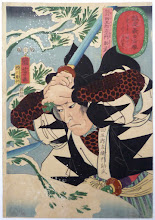I started out playing Mentzer (BECM, never got I until recently on .pdf). In those rules, taking the text from Moldvay, dragon breath weapons (and storm giant lightning bolts) are keyed to the creature's current hit points.
OD&D apparently doesn't say one way or the other, but the way it, Holmes, and AD&D are worded, and the way they do dragon hit points (set points per HD per age category, rather than randomly rolled by HD like other monsters) seems to suggest their breath weapon does not get weaker as they get damaged. It's always the full amount.
2E of course has random damage ranges assigned for dragon breath, rather than keying it to hit points, current or maximum.
Frank Mentzer has commented on Dragonsfoot (here) that in his games, and in the games played in-house at TSR back in the day, dragons always do maximum damage with breath weapons, and that the text in his edition of the Basic Set was either that way because of Moldvay, or someone edited it after he finished with it. He doesn't remember the details. And really it doesn't matter.
What I think is funny is the reasoning lots of people, Frank included, give for not liking decreasing breath weapon damage. Players instantly know how many hit points the dragon has left.
But wait, if it's important to players to know how many hit points it has left, they can surely keep track of how much they've dealt it. Sure, the DM is not obliged to let them know if a dragon made or failed a save vs. a damage spell, but how hard is it, for any D&D player who likes numbers enough to care to track this sort of thing, to keep two or three or more potential totals?
If it's important to DMs that players not metagame the remaining hit points of a dragon, 2E would seem to have the best method, a damage range not keyed to hit points.
Besides, with the OD&D through AD&D method of giving dragons hit points, you can already metagame their potential hit points before they even breathe on you the first time. Small recently hatched red dragon? It's got 10HD, so it's got 10 or 20 hit points only. Really big, really old one? 70 or 80.
Now, the idea that dragons should be kick ass monsters, as Frank also mentions he is a proponent of, is a valid reason to keep the max hit point damage to breath weapons as the dragon gets injured. Then, even as it's down to single digits, its breath is still enough to fry most low to mid level characters.
I'm sticking with the decreasing breath weapon tied to current hit points, though. It's what I've always used, and I like the idea that to fight a dragon, you want to get the jump on it and hit it hard and fast to give yourself the best chance to survive. If you were really fighting a super tough monster like that, I'd think that would be the smart way to do it.
Forward into the Past
43 minutes ago






Wow, until I read this post, I was unaware of the discrepancy. Yes, Moldvay's rules are especially clear (being highlighted in the text), and the Monster Manual I feel is equally clear (based on the example given, the monster is still doing maximum damage after taking 44 points of damage). For the life of me, I can't remember how I handled this in the past (it's been so long since I've DM'd an old school game in which a dragon appeared...I mean YEARS); I'm actually pretty sure I've run it both ways before!
ReplyDeleteSince I'm a B/X man these days and a rules stickler to boot, I'll echo your sentiment of going for the "hit points remaining." It makes more sense in the game context (let's face it: against AD&D characters, dragons are going to need every advantage they can get!). Still remember that in B/X rules a dragon's first attack is ALWAYS their breath weapon (unlike AD&D) and so is more like to do plenty o damage right up front when the beast is strongest. B/X play gives PCs a chance to heroically weaken the dragon, hopefullt defeating it besides their lesser resources.
Cool post. Next great debate: should a Disintegrate spell require a save versus Spells or save versus Death Magic?
; )
Back with my old group when I was a kid, we often spent considerable time thinking up creative ways to get a dragon to waste one of its breaths before the battle started.
ReplyDeleteScarecrows and Ventriloquism spells, Phantasmal Force, and a few other tricks worked from time to time.
But nothing beat finding a sleeping dragon and waking it up with a Lightning Bolt, Fire Ball, or Ice Storm plus a few melee or ranged attacks and if we were lucky a backstab. Get it down as much as possible before it uses that first breath weapon!